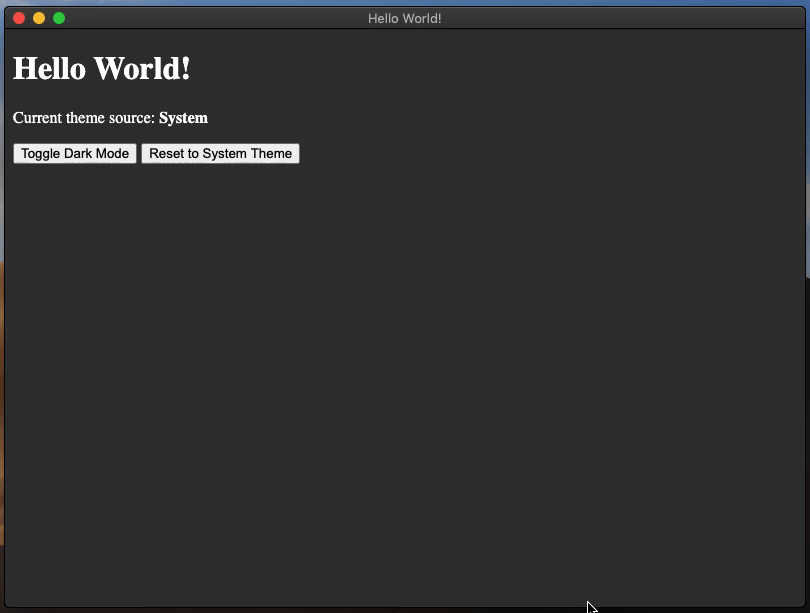Electron Dark Mode
概览
自动更新原生界面
"本地界面"包括文件选择器、窗口边框、对话框、上下文 菜单等 - 任何UI来自操作系统而非应用的界面。 默认行为是从操作系统选择自动主题。
自动更新您自己的界面
如果您的应用有自己的黑暗模式,您应该在与系统黑暗模式设置同步时切换。 你可以通过 prefers-color-scheme CSS 媒体查询来实现此功能.
手动更新您自己的界面
如果你想在亮/暗模式之间手动切换,你可以通过在 nativeTheme 模块的 themeSource 属性中设置所需的模式来实现。此属性的值将传播到您的渲染器进程。任何与 prefers-color-scheme 相关的 CSS 规则都将相应更新。
macOS 设置
在 macOS 10.14 Mojave 中, Apple 为所有 macOS 电脑引入了一个全新的 系统级暗色模式。 如果您的 Electron 应用具有深色模式,您可以 使用"本机 api" 应用。
在 macOS 10.15 Catalina 中,Apple 为所有 macOS 计算机引入了一个新的“自动”暗模式选项。为了让API isDarkMode 和 Tray 在这个模式中正常工作,你需要在 Info.plist 文件里把 NSRequiresAquaSystemAppearance 设置为 false ,或者使用 >=7.0.0 的Electron。
Electron Packager 和 Electron Forge 都有一个 darwinDarkModeSupport 选项,可以在应用程序构建期间自动更改 Info.plist。
如果您希望在使用 Electron > 8.0.0 时选择退出,则必须将 Info.plist 文件中的 NSRequiresAquaSystemAppearance 键设置为 true。请注意,由于使用 macOS 10.14 SDK,Electron 8.0.0 及更高版本不会让您选择退出此主题。
示例
此示例演示了Electron 应用程序从nativeTheme中获取主题颜色。 此外,它还使用 IPC 通道提供主题切换和重置控制。
| main.js | preload.js | index.html | renderer.js | style.css |
|
|
|
|
|
DOCS/FIDDLES/FEATURES/MACOS-DARK-MODE (22.0.2)
它是如何工作的呢?
从 index.html 文件开始:
<!DOCTYPE html>
<html>
<head>
<meta charset="UTF-8">
<title>Hello World!</title>
<meta http-equiv="Content-Security-Policy" content="script-src 'self' 'unsafe-inline';" />
<link rel="stylesheet" type="text/css" href="./styles.css">
</head>
<body>
<h1>Hello World!</h1>
<p>Current theme source: <strong id="theme-source">System</strong></p>
<button id="toggle-dark-mode">Toggle Dark Mode</button>
<button id="reset-to-system">Reset to System Theme</button>
<script src="renderer.js"></script>
</body>
</body>
</html>以及 styles.css 文件:
@media (prefers-color-scheme: dark) {
body { background: #333; color: white; }
}
@media (prefers-color-scheme: light) {
body { background: #ddd; color: black; }
}该示例渲染一个包含几个元素的 HTML 页面。 <strong id="theme-source"> 元素显示当前选中的主题,两个 <button> 元素是 控件。 CSS 文件使用 prefers-color-scheme 媒体查询
设置 <body> 元素背景和文本颜色。
preload.js 脚本在 window对象中添加了一个新的 API叫做 深色模式。 此 API 暴露两个IPC 通道到渲染器进程,分别为 'dark-mode:toggle' 和 'dark-mode:system'。 它还分配了两个方法, toggle 和 system,它们将渲染器中的信息传递到
主进程。
const { contextBridge, ipcRenderer } = require('electron')
contextBridge.exposeInMainWorld('darkMode', {
toggle: () => ipcRenderer.invoke('dark-mode:toggle'),
system: () => ipcRenderer.invoke('dark-mode:system')
})现在,渲染器进程可以安全地与主进程通信,并对nativeTheme 对象执行必要的变更。
renderer.js 文件负责控制 <button> 功能。
document.getElementById('toggle-dark-mode').addEventListener('click', async () => {
const isDarkMode = await window.darkMode.toggle()
document.getElementById('theme-source').innerHTML = isDarkMode ? 'Dark' : 'Light'
})
document.getElementById('reset-to-system').addEventListener('click', async () => {
await window.darkMode.system()
document.getElementById('theme-source').innerHTML = 'System'
})使用 addEventListener, renderer.js 文件将'click' 事件监听器添加到每个按钮元素上。 每个事件监听处理器都会调用到相关的 window.darkmode API
方法。
最后, main.js 文件代表了主进程并包含实际的 nativeTheme API。
const { app, BrowserWindow, ipcMain, nativeTheme } = require('electron')
const path = require('path')
const createWindow = () => {
const win = new BrowserWindow({
width: 800,
height: 600,
webPreferences: {
preload: path.join(__dirname, 'preload.js')
}
})
win.loadFile('index.html')
ipcMain.handle('dark-mode:toggle', () => {
if (nativeTheme.shouldUseDarkColors) {
nativeTheme.themeSource = 'light'
} else {
nativeTheme.themeSource = 'dark'
}
return nativeTheme.shouldUseDarkColors
})
ipcMain.handle('dark-mode:system', () => {
nativeTheme.themeSource = 'system'
})
}
app.whenReady().then(() => {
createWindow()
app.on('activate', () => {
if (BrowserWindow.getAllWindows().length === 0) {
createWindow()
}
})
})
app.on('window-all-closed', () => {
if (process.platform !== 'darwin') {
app.quit()
}
})ipcMain.handle 方法表明主进程如何响应来自 HTML 页面上 按钮的点击事件。
'dark-mode:toggle' IPC 通道处理器方法检查 shouldUseDarkColors boolean属性 设置对应的 themeSource, 然后返回当前的 shouldUseDarkColors 属性。 回顾此 IPC 通道的渲染器进程事件监听器,此处理器的返回值为 <strong id='theme-source'> 元素指定正确的文本。
'dark-mode:system' IPC 通道处理器方法将字符串 'system' 赋值到 themeSource 同时无返回值。 这也对应于相应的渲染器进程事件监听器,因为方法正在等待,且不需要返回值。
使用Electron Fiddle运行示例,然后点击“切换深色模式”按钮; 应用程序应该开始在亮色和黑色背景颜色之间交替。


 免费 AI IDE
免费 AI IDE



更多建议: